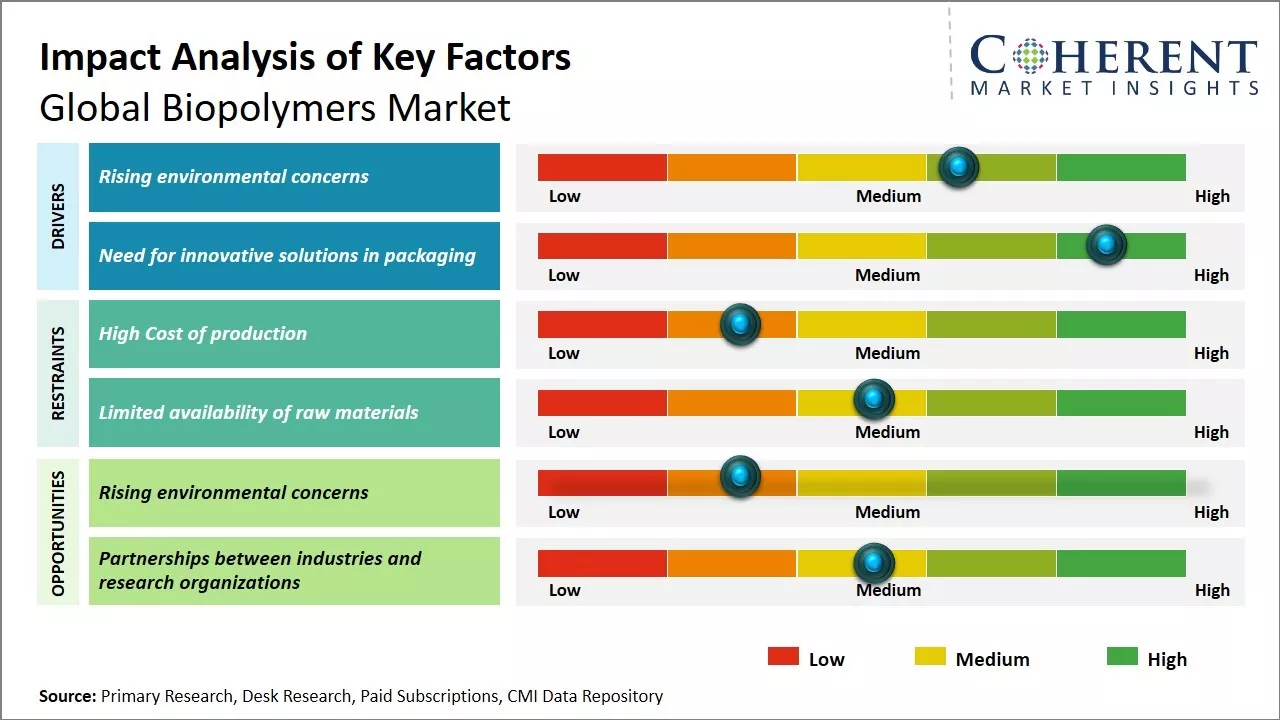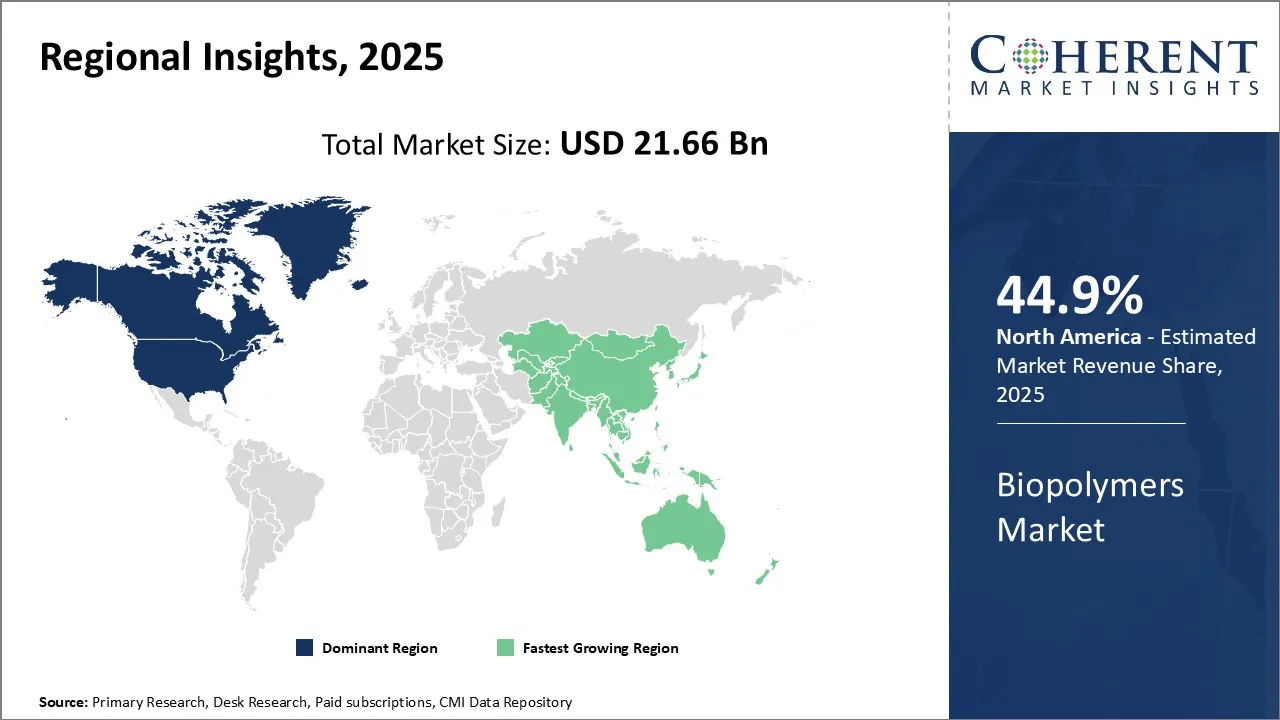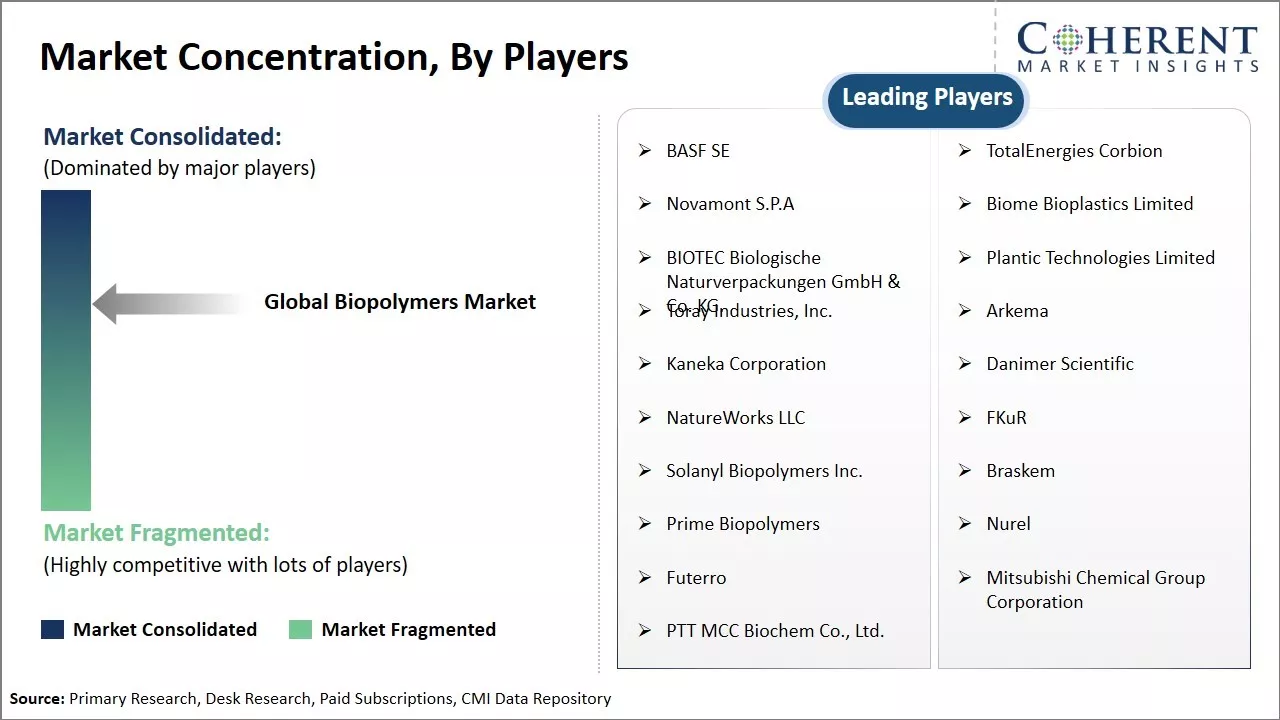
The Global Biopolymers Market is estimated to be valued at USD 21.66 Bn in 2025 and is expected to reach USD 45.86 Bn by 2032, exhibiting a compound annual growth rate (CAGR) of 11.3% from 2025 to 2032.

To learn more about this report, Download Free Sample
Biopolymers are gaining widespread acceptance as eco-friendly alternatives to oil-based plastics. Rising concerns over plastic waste and carbon emissions have boosted biopolymers market demand across industries like packaging, textiles, agriculture, and healthcare. Growing environmental awareness is driving consumers and manufacturers to adopt biodegradable polymers and prioritize sustainable raw material sourcing and production practices.
|
Current Event |
Description and its Impact |
|
Global Regulatory Push for Plastic Waste Reduction |
|
|
Supply Chain Disruptions and Raw Material Price Volatility |
|
Uncover macros and micros vetted on 75+ parameters: Get instant access to report
Artificial Intelligence (AI) is playing a transformative role in the biopolymers market by accelerating innovation, improving production efficiency, and supporting sustainability goals. AI-powered modeling tools are helping researchers design and simulate new biopolymer structures with enhanced properties like biodegradability and thermal stability. In manufacturing, AI is optimizing fermentation and processing conditions, reducing energy use and material waste. These advancements are lowering production costs and making biopolymers more competitive with traditional plastics. Additionally, AI is being used to assess environmental impact through lifecycle analysis, helping companies align with ESG standards. In packaging, AI enables the development of smart biopolymer materials that respond to environmental changes, offering added functionality in food and healthcare applications. As AI continues to integrate across R&D and industrial processes, it is expected to significantly boost the scalability, performance, and adoption of biopolymers worldwide.
For instance, in September 2025, Colgate-Palmolive partnered with Erthos to use its Zya AI platform for biomaterials development, focusing on sustainable packaging solutions. The collaboration aims to accelerate the creation of plant-based biopolymers, reducing reliance on traditional plastics. This move highlights Colgate’s commitment to eco-friendly innovation and supports the broader shift toward AI-driven sustainability in consumer goods.
In terms of type, the biodegradable plastics segment contributes the largest share in 2025 of the global biopolymers market driven by increasing global awareness of plastic pollution and stringent regulations against single-use plastics. These materials, which include polylactic acid (PLA), polyhydroxyalkanoates (PHA), and starch-based polymers, offer composability and reduced environmental impact. Governments and corporations are investing heavily in sustainable alternatives, and biodegradable plastics are being adopted across packaging, agriculture, and consumer goods. Their versatility and ability to degrade naturally make them a preferred choice over bio-based but non-biodegradable options like Bio-PET and Bio-PE.
For instance, in August 2025, India’s easternmost railway zone, Northeast Frontier Railway, adopted compostable bio-plastic on its trains, replacing conventional single-use plastic items. The initiative, launched on World Environment Day, includes biodegradable packaging for food and water, aiming to reduce plastic waste and promote sustainability across its network. This marks a significant step in eco-conscious rail travel.
In terms of application, the films segment is expected to hold the highest share of the market in 2025, due to their extensive use in packaging, agriculture, and hygiene products. Biopolymer-based films are lightweight, flexible, and capable of providing barrier properties similar to conventional plastics. In food packaging, they help extend shelf life while being compostable, aligning with consumer demand for eco-friendly solutions. Agricultural mulch films made from biopolymers also reduce soil contamination and improve crop yield. The rise of e-commerce and demand for sustainable wrapping materials further propels this segment’s growth.
For instance, in October 2025, Taghleef Industries unveiled the new generation of NATIVIA® films—bio-based and biodegradable solutions made from renewable resources like PLA. The relaunch emphasizes enhanced performance, sustainability, and alignment with circular economy goals, offering eco-conscious packaging alternatives for converters and brand owners seeking to reduce environmental impact.
In terms of end-use industry segments, the packaging contributes the 37.3% share in 2025 of the global biopolymers market. This dominance stems from the urgent need to replace petroleum-based plastics in food, beverage, and consumer goods packaging. Biopolymers offer a sustainable alternative that meets both functional and environmental requirements. Major brands are shifting toward biodegradable and bio-based packaging to meet ESG goals and consumer expectations. Regulatory support, such as bans on plastic bags and mandates for compostable materials, has accelerated adoption, making packaging the cornerstone of biopolymer demand.
For instance, in October 2025, CJ Biomaterials unveiled a new PHA-based platform designed for compostable food packaging and serviceware. The innovative material offers excellent barrier properties and is certified for both home and industrial composting. Targeting cups, trays, and lids, the launch supports growing demand for sustainable packaging and aligns with global efforts to reduce plastic waste.

To learn more about this report, Download Free Sample
North America has maintained its dominance in the global biopolymers market over the past decade and remains the largest regional market with 44.9% share in 2025. The U.S. is home to several fortune 500 companies that are major players in the bioplastics industry. Strong government support through regulatory policies promoting sustainable alternatives to conventional plastics has driven extensive R&D and commercialization of biopolymers in the region. Many biopolymer manufacturers are shifting production capacities to the North American region to better serve the local market. The automotive, packaging and healthcare industries in the U.S. and Canada have also increased the adoption of biopolymers for their strong focus on reducing carbon footprint.
For instance, in January 2025, Metaflo and Super Copper have formed a joint venture in Canada to develop biopolymer-based solutions for copper mining. The partnership aims to enhance environmental performance in tailings management and water usage by replacing traditional chemical treatments with sustainable, bio-based alternatives. This initiative supports greener mining practices and aligns with global ESG goals.
The Asia Pacific region has emerged as the fastest growing market for biopolymers globally in recent years. Countries like China, India, Indonesia, and Thailand have seen explosive growth in their economies and manufacturing capabilities. This industrial expansion has significantly boosted the demand for bioplastics as well. The presence of abundant natural resources and cheap labor availability makes Asia Pacific an attractive production base for biopolymer companies. Many leading European players have established production plants in the major Asian economies. Additionally, the large and growing domestic consumer markets in the region for packaged food, healthcare, and other consumer products drives biopolymer consumption. With sustained double-digit GDP growth projected over the next decade, the Asia Pacific region is well-positioned to dominate the global biopolymers industry in the long term.
For instance, in September 2025, SGInnovate has led a USD 1.5 million seed funding round for Greenitio, a Singapore-based startup developing sustainable biopolymer materials. The investment will support Greenitio’s efforts to replace conventional plastics with biodegradable alternatives for packaging and consumer goods. This move highlights growing regional interest in climate tech and circular economy solutions.
The U.S. biopolymers market is booming due to rising environmental awareness, stricter regulations on plastic waste, and growing demand for sustainable packaging. Industries like food, healthcare, and consumer goods are shifting to renewable materials such as PLA and starch-based biopolymers, which offer biodegradability, cost-effectiveness, and versatility.
For instance, in January 2025, Tous Les Jours launched plant-based straws in its U.S. stores, made with PHACT™ PHA, a low-carbon biopolymer developed by CJ Biomaterials. The biodegradable straws mark a step toward sustainable foodservice packaging, aligning with the brand’s commitment to reducing plastic waste and promoting eco-friendly alternatives in everyday consumer products.
Japan’s biopolymers market is expanding due to strict government policies targeting plastic waste, increasing consumer preference for eco-friendly products, and ongoing innovation in biodegradable materials. Sectors such as packaging, agriculture, and healthcare are actively transitioning to bio-based alternatives like PLA and PHA to support sustainability and reduce environmental impact.
For instance, in December 2024, Starbucks Japan introduced biodegradable straws made from Green Planet™, a plant-based biopolymer derived from plant oils. Initially launched in 32 Okinawa stores, the straws will roll out nationwide by March 2025. Designed to reduce plastic waste and carbon emissions, the initiative supports Starbucks’ goal of cutting waste by 50% by 2030.
| Report Coverage | Details | ||
|---|---|---|---|
| Base Year: | 2024 | Market Size in 2025: | USD 21.66 Bn |
| Historical Data for: | 2020 To 2024 | Forecast Period: | 2025 To 2032 |
| Forecast Period 2025 to 2032 CAGR: | 11.3% | 2032 Value Projection: | USD 45.86 Bn |
| Geographies covered: |
|
||
| Segments covered: |
|
||
| Companies covered: |
Celanese, BASF SE, TotalEnergies Corbion, Novamont S.P.A, Biome Bioplastics Limited, BIOTEC Biologische Naturverpackungen GmbH & Co. KG., Plantic Technologies Limited, Toray Industries, Inc., Arkema, Kaneka Corporation, Danimer Scientific, NatureWorks LLC, FKuR, Solanyl Biopolymers Inc., Braskem, Prime Biopolymers, Nurel, Futerro, Mitsubishi Chemical Group Corporation, and PTT MCC Biochem Co., Ltd. |
||
| Growth Drivers: |
|
||
| Restraints & Challenges: |
|
||
Uncover macros and micros vetted on 75+ parameters: Get instant access to report
Rising environmental concerns and strict regulations on single-use plastics are driving global demand for biodegradable alternatives, boosting the biopolymers market share. Biopolymers, derived from renewable sources like corn starch and sugarcane, offer biodegradability and sustainability. Industries and consumers are shifting from petroleum-based plastics to eco-friendly options for packaging and consumer goods. As governments enforce bans and producer responsibility laws, biopolymers are replacing conventional plastics in items like straws, bags, and cutlery. With growing adoption across food, beverage, and retail sectors, biopolymers are emerging as a key solution to reduce plastic waste and support global sustainability goals.

To learn more about this report, Download Free Sample
Traditional plastic packaging is facing scrutiny due to waste and recyclability concerns, pushing the industry toward sustainable alternatives. Biopolymers offer a plant-based solution that mimics plastic performance but decomposes without leaving microplastics. Their compostability and eco-friendly appeal have driven research into bio-PET, PLA, and PBS applications, boosting biopolymers market value across food, consumer goods, and e-commerce packaging sectors.
Rising environmental concerns are fueling demand for sustainable alternatives to petroleum-based plastics, boosting the biopolymers market forecast. Governments worldwide are introducing regulations and incentives to promote bioplastics adoption. Meanwhile, technological advancements are lowering production costs and enabling the development of innovative biopolymer varieties, expanding their applications across industries and reinforcing their role in a greener future.
The biopolymers market stands at a strategic crossroads where technological maturity meets commercial headwinds. Despite rapid capacity additions, global utilization remains below 60%, reflecting persistent cost and infrastructure challenges. Polylactic acid (PLA) dominates industrial uptake, supported by scalable fermentation routes and new plants exceeding 70,000 tpa, yet its economics remain vulnerable to lactic acid price swings and competition from low-cost fossil polymers.
In contrast, polyhydroxyalkanoates (PHAs) continue to face scale-up barriers, as extraction and purification costs outweigh fermentation efficiency gains. Several PHA-focused ventures have recently downsized or exited, highlighting weak cost competitiveness despite strong biodegradability credentials. Market adoption is bifurcating into packaging, textiles, and regulated single-use applications benefit from sustainability mandates, whereas bulk segments like films and rigid plastics resist transition due to pricing and performance constraints.
Policy pressure alone cannot guarantee market traction without supporting waste-management and composting infrastructure to validate end-of-life claims. Integration across feedstock sourcing, manufacturing, and recovery processes remains the defining success factor. Overcapacity is likely to trigger consolidation and asset rationalization, favoring firms that pair credible environmental differentiation with disciplined cost structures. Ultimately, long-term resilience will depend on aligning material innovation with real-world circularity and credible lifecycle performance.
Definition: The Global Biopolymers Market refers to the market for biodegradable plastics and polymers that are derived from renewable biomass sources such as corn starch, cellulose, and sugar cane. This includes products made from polylactic acid (PLA), polyhydroxyalkanoates (PHA), bio-polyesters, bio-polyamides and other biodegradable polyesters which can be used to manufacture plastic bottles, packaging films, bags and other consumer products.
Share
Share
About Author
Yash Doshi is a Senior Management Consultant. He has 12+ years of experience in conducting research and handling consulting projects across verticals in APAC, EMEA, and the Americas.
He brings strong acumen in helping chemical companies navigate complex challenges and identify growth opportunities. He has deep expertise across the chemicals value chain, including commodity, specialty and fine chemicals, plastics and polymers, and petrochemicals. Yash is a sought-after speaker at industry conferences and contributes to various publications on topics related commodity, specialty and fine chemicals, plastics and polymers, and petrochemicals.
Missing comfort of reading report in your local language? Find your preferred language :
Transform your Strategy with Exclusive Trending Reports :
Frequently Asked Questions
Joining thousands of companies around the world committed to making the Excellent Business Solutions.
View All Our Clients